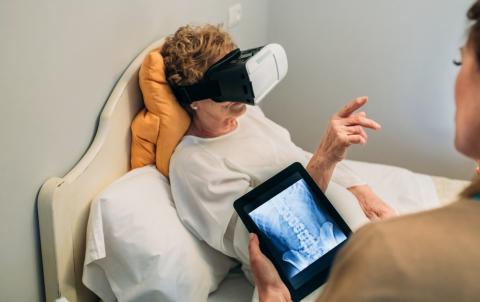How can 'machines that think' shape the future of physiotherapy?

Artificial intelligence (AI) will not replace physiotherapists, but there is much to gain by embracing it.
What can artificial intelligence do?
AI can:
Help to reduce unwarranted variation in clinical practice.
Address inefficiencies.
Remove unnecessary stressors that obstruct clinical work.
What would 'physio utopia' look like?
Less time spent writing clinical notes?
Automated collection and analysis of patient-reported outcome measures?
Easy-to-access, up-to-date guidelines and research, and suggestions on how to apply them?
AI can provide these things, and more, and move us towards the physiotherapy provision of the future.
What is AI?
The term AI describes a computer’s ability to perform tasks normally requiring human intelligence – that is, machines that can ‘think’. Machine learning (ML) is a field of study that gives computers the ability to learn without being explicitly programmed. This enables them to recognise patterns in data to classify and make predictions.
AI systems that ‘think’ and ‘learn’ as humans do are some way off, but they can be a tool to assist in the analysis of healthcare data.
Humans are great at recognising patterns. This is key to developing clinical reasoning skills as a physiotherapist. But when we start to consider larger data sets, such as at population level, we need help. Advances in computing, cheaper storage solutions for electronic information and greater understanding of the power of data science now allow pattern recognition at a level far beyond human ability.
ML exists on a continuum from ‘supervised’ to ‘unsupervised’ (see below).
Supervised learning
Supervised learning is where the computer has access to labelled examples. For example, physiotherapists use knowledge of similar patients to produce a differential diagnosis. This is the predominant method of machine learning used in healthcare.
One popular form of supervised learning is deep learning. This uses layers of algorithms (neural networks) to process information in a manner similar to how the brain works.
This has been used to develop decision-support tools to direct patients with back pain to the appropriate management pathway.
Unsupervised learning
Unsupervised learning is where data is not labelled with the correct ‘answer’ and the computer finds previously unidentified patterns.
Such methods have been used to evaluate electronic health records and find unknown patterns of patient characteristics that predict their likelihood of future diseases.
The potential for such classification and prediction in physiotherapy is huge and can reduce clinical variation in care, allowing professionals to ‘get it right first time’. Cost is subsequently reduced and quality of care enhanced.
Big data
The success of machine learning depends on the accuracy and amount of data available to teach the system. ‘Big data’ in healthcare refers to large data sets that can be analysed to identify patterns related to patient behaviour and outcomes.
Such data is growing and is likely to exceed the manpower required to manage it efficiently. More importantly, it's an opportunity represented through a step-change from AI that relies on human input to data-driven AI.
Big data in healthcare takes many forms. It includes:
Patient details stored in electronic care records.
Information contained in medical imaging.
Information shared in health apps on individuals's smartphones.
Streams of data generated from wearable or implanted sensors.
The development of AI technologies to assist with the processing of big data is essential to deal with this challenge. Big data is also the information from which ML can learn.
Two types of techniques are important to consider for physiotherapists:
Descriptive modelling (discovering previously unknown patterns in data). For example:
Describing the characteristics of a population of patients attending a specific service or with a specific condition (eg, cardiovascular disease).
Predictive modelling (predicting an event or outcome from available data). For example:
Predicting development of diabetes mellitus.
Predicting asthma exacerbations from telemedicine data.
Predicting treatment outcome for depression.
Risks
AI has many benefits for healthcare. It can enhance its performance, make medical knowledge more accessible and optimise application of resources. However, there are risks associated with AI in healthcare.
Data availability
The greatest obstacle for big data in healthcare is the variation in types of data collected during usual care. For example, patient demographics, measures, treatments and outcomes. Typically, data resides across multiple databases and in different formats. This can lead to difficulties in seeing the whole picture.
Information is often recorded in such a way that it makes it difficult for AI algorithms to identify patterns. For example, one clinician’s records may contain different terminology from another’s. This problem is amplified when we are searching for patterns in data that comes from different NHS trusts.
Misapplication of data
Patterns found in patient-population data may be biased towards or against one particular patient group.
Errors
Even when computer systems are working beyond human accuracy levels, very few are 100 per cent accurate.
If AI is used to diagnose a tumour on an MRI scan, and a decision-support system advises the clinician of the diagnosis, who is to blame for this mistake?
Ethical considerations
Regulation of AI is extremely important but has so far been left in the hands of AI researchers and companies. Regulation infrastructure is only just being formed. There is much to gain from developing an ethical framework for implementing AI techniques in the NHS. Adherence to ethical principles promotes confidence among clinicians and patients.
There is a growing understanding of how to design systems that can lead to better insights and improved treatments while minimising risk and protecting personal data. Following an appropriate governance framework should minimise the misapplication of AI technology and ensure such systems are directed towards the needs of patients. Engagement by clinicians is key to ensuring AI is safe, ethical and effective.
People also need to know their privacy and rights are safeguarded. They need to understand how and when data about them is used and shared. One way to ensure due consideration is given to the use of personal data is through a data protection impact assessment (DPIA). For more information on DPIAs see the Information Commissioner’s Office website.
Machines + humans
Healthcare professionals are key members of the interdisciplinary data science team. To harness the potential of big data and inform and improve the way we deliver care, healthcare workers need the skills necessary to translate problems into analytical questions and ensure that insights generated translate into impact for the organisation (Henke et al 2018, Topol 2019).
AI is a tool that humans can use to facilitate better patient care. However, AI cannot work alone. Humans (both the NHS workforce and service users) provide the context required to extrapolate AI outputs into real life. Only through a human lens can AI effectively benefit healthcare; and only collaboratively can the future healthcare environment flourish.
Glossary
Artificial intelligence (AI): a computer’s ability to perform tasks normally requiring human intelligence
Big data: large amounts of patient information that can be analysed to identify patterns related to patient behaviour and outcomes
Data mining: the examination and analysis of large amounts of patient data in existing databases
Descriptive analytics: examining data to discover previously unknown patterns
Machine learning: a field of study that gives computers the ability to learn without being explicitly programmed
NHSX: a new unit, consisting of teams from the Department of Health and Social Care, NHS England and NHS Improvement, that is driving forward the digital transformation of health and social care
Predictive analytics: examining data to predict events or outcomes
References
Aumueller J (2019) How artificial intelligence can revolutionise healthcare. Health Europa Quarterly. 13, 10, 228-229.
Henke N, Levine J, McInerney P (2018) You don’t have to be a data scientist to fill this must-have analytics role. Harvard Business Review. February 5.
Samuel AL (1959) Some studies in machine learning using the game of checkers. IBM Journal of Research and Development. 44, 1, 210-229.
Tack C (2019) Artificial intelligence and machine learning applications in musculoskeletal physiotherapy. Musculoskeletal Science and Practice. 1, 39, 164-169.
Topol E (2019) The Topol Review. Preparing the Healthcare Workforce to Deliver the Digital Future. An Independent Report on Behalf of the Secretary of State for Health and Social Care. NHS.
Authors:
Chris Tack
Andy Carr
Lisa Kent
Emma Salt
Ross Clifford
Edited by Daniel Allen



